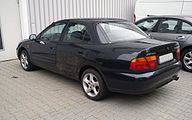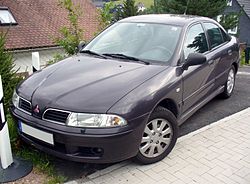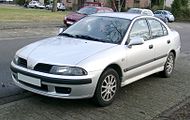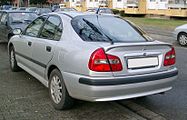Mitsubishi Carisma
| Mitsubishi Carisma | |
|---|---|
| Production period: | 1995-2004 |
| Class : | Middle class |
| Body versions : | Limousine , station wagon |
| Successor: | Mitsubishi Lancer |
The Mitsubishi Carisma is a passenger car model from the Japanese manufacturer Mitsubishi , which was produced in the Netherlands from summer 1995 to the end of 2004 together with the Volvo S40 / V40 .
Technically, the car therefore shares some components with Volvo , but also with Renault , e.g. B. the transmission. However, not every vehicle has such a transmission. The vehicles in question can be recognized by the reverse gear lock typical of Renault, which makes it necessary to lift a ring underneath the gear knob to engage reverse gear. The 1.6 and 1.8 l engines (including the MSX) are equipped with Renault gearboxes - the GDI, on the other hand, has Mitsubishi gearboxes.
Carisma (DA1A, 1995-1999)
| Carisma (DA1A) | |
|---|---|
|
Mitsubishi Carisma hatchback (1995–1999) |
|
| Production period: | 1995-1999 |
| Body versions : | Limousine , station wagon |
| Engines: |
Otto engines : 1.6–1.8 liters (66–103 kW) Diesel engine : 1.9 liters (66 kW) |
| Length: | 4435-4445 mm |
| Width: | 1710 mm |
| Height: | 1405 mm |
| Wheelbase : | 2550 mm |
| Empty weight : | 1080-1270 kg |
In the summer of 1995, the Mitsubishi Carisma was presented to the public as a hatchback . It is the first Mitsubishi produced in the Netherlands by NedCar (a joint venture between Volvo , Mitsubishi and the Dutch state). It is characterized by a large interior for its class. The Carisma was initially offered with a 1.6- and 1.8-liter four-cylinder petrol engine with 66 kW (90 hp) and 85 kW (115 hp), respectively.
In autumn 1996, a classic notchback sedan followed with a little more luggage space (480 liters instead of 430 liters). This version is an in-house, more powerfully motorized and therefore also more expensive alternative to the somewhat smaller Lancer , which was introduced at the same time , but is much less popular than the hatchback. A diesel engine was introduced into the Carisma at the same time as the notchback version. It came from the Renault 19 and developed 66 kW (90 hp) from a displacement of 1.9 liters.
In the summer of 1997, the Carisma became a vehicle of innovation for Mitsubishi in Europe: It received the 1.8-liter GDI engine with 92 kW (125 hp), which replaced the conventional 1.8-liter engine. It is the first gasoline engine with direct injection to be offered in large series in Europe. As a notchback version, the Carisma 1.8 GDI was also exported to Japan for a short time.
In Europe the Carisma was available with the following equipment: GL, GLX / LX and as GLS / LS, as well as some special models such as GDI EXE or MSX with 103 kW (140 PS). The GDI direct injection engine is a very economical engine which, with appropriate maintenance, can also achieve high mileage, these engines have also proven to be very reliable.
The favorable consumption and engine output speak in favor of the GDI engine. However, there is a contradiction in terms of the possible coking of the intake tract due to exhaust gas recirculation, which can impair fuel consumption and engine response.
Technical specifications
| 1.6 | 1.8 | 1.8 MSX 1 | 1.8 GDI | 1.9 TD | |
|---|---|---|---|---|---|
| Construction period | 07.1995-05.1999 | 07.1995-07.1997 | 08.1997-05.1999 | 09.1996-05.1999 | |
| Engine characteristics | |||||
| Engine identification | 4G92 | 4G93 | F8QT 2 | ||
| Engine type | R4 petrol engine | R4 diesel engine | |||
| Number of valves per cylinder | 4th | 2 | |||
| Valve control | OHC , timing belt | DOHC, timing belt | OHC, timing belt | ||
| Mixture preparation | Manifold injection | Common rail injection |
Swirl chamber injection |
||
| Engine charging | - | Turbocharger , intercooler | |||
| cooling | Water cooling | ||||
| Bore × stroke | 81.0 mm × 77.5 mm | 81.0 mm × 89.0 mm | 80.0 mm × 93.0 mm | ||
| Displacement | 1597 cc | 1834 cc | 1870 cc | ||
| Compression ratio | 10.0: 1 | 10.5: 1 | 12.5: 1 | 20.5: 1 | |
| Max. Power at 1 / min |
66 kW (90 PS) / 5500 |
85 kW (115 PS) / 5500 |
103 kW (140 PS) / 6500 |
92 kW (125 PS) / 5500 |
66 kW (90 PS) / 4250 |
| Max. Torque at 1 / min |
137 Nm / 4000 |
162 Nm / 4500 |
167 Nm / 5000 |
174 Nm / 3750 |
176 Nm / 2250 |
| Emission standard | Euro 2 | ||||
| Power transmission | |||||
| drive | Front wheel drive | ||||
| Gearbox, as standard | 5-speed manual transmission | ||||
| Gearbox, optional | 4- speed automatic transmission | - | 4-stage automatic transmission |
- | |
| Measured values 3 | |||||
| Top speed | 180 km / h | 200 km / h | 215 km / h | 205 km / h | 180 km / h |
| Acceleration, 0-100 km / h | 12.0 s (14.3 s) |
10.2 s (12.0 s) |
9.2 s | 10.0 s (11.2 s) |
13.2 s |
| Fuel consumption over 100 km (combined) | 7.4 L S (7.1 L S) |
6.9 l S (7.5 l S) |
6.7 l p | 5.3 L S (7.3 L S) |
6.0 l D |
| Remarks | |||||
| not for E10 fuel suitable |
|||||
- The availability of the engines depended on the model, equipment and market.
Carisma (DA2A, 1999-2004)
| Carisma (DA2A) | |
|---|---|
|
Mitsubishi Carisma hatchback (1999-2002) |
|
| Production period: | 1999-2004 |
| Body versions : | Limousine , station wagon |
| Engines: |
Otto engines : 1.6–1.8 liters (73–92 kW) Diesel engines : 1.9 liters (66–85 kW) |
| Length: | 4475 mm |
| Width: | 1710 mm |
| Height: | 1405 mm |
| Wheelbase : | 2550 mm |
| Empty weight : | 1200-1365 kg |
| Stars in the Euro NCAP - Crash Test |
|
In the early summer of 1999, the Carisma was heavily revised both optically and technically. The 1.6-liter petrol engine now has an output of 73 kW (100 hp) and new equipment lines have been introduced: the standard Classic model , the Comfort that is suitable for long journeys , the sporty Avance version and the sophisticated version called Elegance .
In summer 2000 the GDI engine was revised. It received a modified throttle valve housing, different engine software and a modified high-pressure pump unit and now has an output of 90 kW (122 hp). In addition, the old diesel was replaced by two new 1.9 DI-D engines ( common rail diesel ) with either 75 kW (102 hp) or 85 kW (115 hp) from the Renault shelf. They are considered to be particularly quiet and economical.
Also in 2000 the special model Dynamics appeared, which represented the high point of the Carisma series. It had a body kit developed by the Formula 1 specialist Fondmetal (Minardi) and 17-inch rims and was only available with the GDI engine. At the same time, the 1.6-liter engine was optimized again and now has an output of 76 kW (103 hp).
In the fall of 2002 the Carisma received another slight facelift, recognizable by the darkened headlights, new seat covers and silver Mitsubishi emblems; In addition, the cockpit design has been changed (changed steering wheel layout). In Germany, the notchback version fell out of the range at the same time. In mid-2003, the 1.8-liter GDI gasoline direct injection engine was removed from the range.
At the end of 2004, production of the Carisma was discontinued in favor of the Colt , which had recently been introduced and which rolled off the production line in Born from then until the end of 2012. The successor to the Carisma was the Lancer, which has been offered as a notchback and station wagon since autumn 2003. Despite its larger external dimensions, the Lancer offers less space inside than the Carisma.
Since the Mitsubishi Lancer did not officially exist in Germany from 1999 to 2003, the Lancer Evolution based on it was temporarily sold as the Carisma GT Evolution .
Technical specifications
| 1.6 | 1.8 GDI | 1.9 TD | 1.9 DI-D MP | 1.9 DI-D HP | |||
|---|---|---|---|---|---|---|---|
| Construction period | 06.1999-07.2000 | 08.2000–12.2004 | 06.1999-07.2000 | 08.2000-06.2003 | 06.1999-07.2000 | 08.2000–12.2004 | |
| Engine characteristics | |||||||
| Engine identification | 4G92 | 4G93 | F8QT 1 | F9Q1 1 | F9Q2 1 | ||
| Engine type | R4 petrol engine | R4 diesel engine | |||||
| Number of valves per cylinder | 4th | 2 | |||||
| Valve control | OHC , timing belt | DOHC, timing belt | OHC, timing belt | ||||
| Mixture preparation | Manifold injection | Common rail injection |
Swirl chamber injection |
Common rail injection | |||
| Engine charging | - | Turbocharger , intercooler | |||||
| cooling | Water cooling | ||||||
| Bore × stroke | 81.0 mm × 77.5 mm | 81.0 mm × 89.0 mm | 80.0 mm × 93.0 mm | ||||
| Displacement | 1597 cc | 1834 cc | 1870 cc | ||||
| Compression ratio | 10.0: 1 | 12.0: 1 | 11.6: 1 | 20.5: 1 | 18.3: 1 | ||
| Max. Power at 1 / min |
73 kW (99 PS) / 5750 |
76 kW (103 PS) / 6000 |
92 kW (125 PS) / 5500 |
90 kW (122 hp) 2 /5500 |
66 kW (90 PS) / 4250 |
75 kW (102 PS) / 4000 |
85 kW (115 PS) / 4000 |
| Max. Torque at 1 / min |
137 Nm / 4000 |
141 Nm / 4500 |
174 Nm / 3750 |
176 Nm / 2250 |
215 Nm / 1700 |
265 Nm / 1800 |
|
| Emission standard | Euro 2 | Euro 3 | Euro 2 | Euro 3 | Euro 2 | Euro 3 | |
| Power transmission | |||||||
| drive | Front wheel drive | ||||||
| Gearbox, as standard | 5-speed manual transmission | ||||||
| Gearbox, optional | 4- speed automatic transmission | - | |||||
| Measured values 3 | |||||||
| Top speed | 190 km / h (185 km / h) |
185 km / h (180 km / h) |
200 km / h | 180 km / h | 190 km / h | 195 km / h | |
| Acceleration, 0-100 km / h | 12.1 s (15.0 s) |
12.4 s (15.1 s) |
10.4 s (12.4 s) |
13.2 s | 11.9 s | 10.4 s | |
| Fuel consumption over 100 km (combined) | 7.2 L S (8.3 L S) |
7.3 L S (8.4 L S) |
6.7 l S (7.6 l S) |
6.0 l D | 5.4 l D | ||
| CO 2 emissions (combined) | 170 g / km (196 g / km) |
161 g / km (183 g / km) |
158 g / km | k. A. | |||
| Remarks | |||||||
| not for E10 fuel suitable | with VTG turbocharger | ||||||
- The availability of the engines depended on the model, equipment and market.
chronology
- 1995
August:
- Launch of the Carisma as a hatchback with the following engines:
- 1.6 (66 kW / 90 PS)
- 1.8 (85 kW / 115 PS)
- 1.8 MSX (103 kW / 140 PS, not on the German market)
- 1996
September:
- Introduction of the notchback version.
- Introduction of the 1.9-liter turbodiesel with 66 kW (90 hp) in the hatchback.
- Passenger airbag and ABS as standard for all models.
- 1997
August:
- Introduction of the petrol direct injection engine 1.8 GDI with an output of 92 kW (125 PS). The unit replaced the previous 1.8 with 85 kW (115 PS) and the 1.8 MSX with 103 kW (140 PS) not offered in Germany.
- Side airbags as standard for all models.
- 1999
June:
- Comprehensive facelift
- The 1.6-liter petrol engine now delivers 73 kW (99 hp).
- 2000
August:
- New engines:
- 1.6-liter petrol engine now with 76 kW (103 PS).
- The 1.8-liter gasoline direct injection (GDI) with manual transmission now has 90 kW (122 hp).
- The old turbodiesel with 66 kW (90 PS) is being replaced by two new common rail engines with 75 kW (102 PS) and 85 kW (115 PS).
- 2002
October:
- Slight facelift (including dark contrasting headlights and silver brand logos)
- Notchback version is omitted
- 2003
June:
- Elimination of the 1.8 GDI.
- 2004
December:
- The series is discontinued in favor of the Lancer, which appeared in autumn 2003.
literature
- Automobile revue . Catalog 1998, 2000 and 2001.
- ADAC special used car guide 2002. Munich, January 2002. ISBN 3-89905-055-X
- ADAC special used car guide 2006. Munich, January 2006. ISBN 3-89905-333-8
Web links
- Data and facts on all Mitsubishi Carisma models
- Former brochures ( Memento from February 26, 2010 in the Internet Archive )
Individual evidence
- ↑ Elimination of coking in the intake tract ( Memento from April 5, 2013 in the Internet Archive )
- ↑ a b E10 compatibility of motor vehicles ( Memento of the original from May 11, 2011 in the Internet Archive ) Info: The archive link was inserted automatically and has not yet been checked. Please check the original and archive link according to the instructions and then remove this notice. As of December 1, 2011. Accessed September 14, 2014.
- ↑ Crash test Mitsubishi Carisma (2001)







